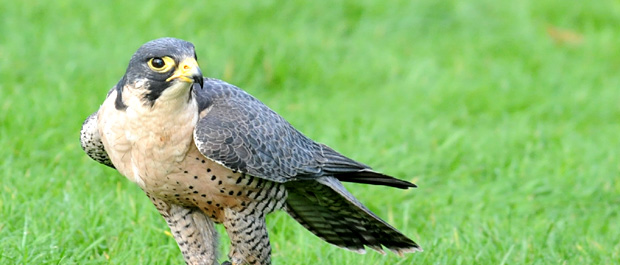Stonehenge

One of the two peregrine chicks that hatched on Salisbury Cathedral Tower last year has been spotted 81 miles (as the crow flies) away from home.
The female peregrine, named Aveline by Cathedral staff, was caught on camera in Floodplain Forest Nature Reserve, Old Wolverton near Milton Keynes, by wildlife photographer and blogger Ashley Beolens, who identified her by her distinctive blue ring, which bears the initials SC.
Her brother, Raphael, has not yet been sighted. He carries a blue ring with the initials ST.
Ashley Beolens said: “I was watching the female peregrine hunting and noticed the ring, so I tweeted a picture asking if anyone knew anything about coloured rings on peregrine falcons. Pretty quickly I heard back from Ed Drewitt, who has ringed all Salisbury Cathedral’s peregrines. While I was watching her she was hunting wading birds and tried to snatch an egret, which got away. It was amazing seeing her in action.”
This peregrine sighting is a first for the Cathedral. Aveline is only one of nine falcons that have fledged from the Tower in recent years to be seen again after leaving the Close.
For Philip Sheldrake, the RSPB Conservation Officer who has worked with the Cathedral’s Clerk of the Works, Gary Price to bring the peregrines back to the Cathedral after sixty years absence, nearly five years of patient work has paid dividends.
Philip Sheldrake said: “It is great news. We thought when she left in late summer 2016 that we’d never see or hear about her again. Peregrines travel great distances and only one in every seven ringed in the South West area is ever sighted again after leaving the nesting site.”
All birds ringed the Bristol and West region (which includes Salisbury) carry the distinctive blue ring which is a regional trademark, and each ring bears unique initials that identify that particular bird. The man who oversees ringing in the South West is Ed Drewitt, a freelance naturalist and specialist ringer.
Ed Drewitt said: “My hunch is that Floodplain Forest is a temporary home and our female peregrine is just passing through, spending the winter in a place where there is a ready supply of ducks and wading birds to feed on. She’ll probably move on in the spring and given that she is only six months old it will be at least a year before she finally settles down and breeds.”
Incubation, hatching and fledging
The peregrines at Salisbury generally lay their eggs at the end of March and incubation begins once the last egg is laid, taking around 29-32 days per egg. The chicks hatch over a period of a couple of days, and initially the brooding and feeding of the young is carried out by the female, while the male hunts to supply the food – but after the first couple of week the female takes up her share of hunting duties.
The young fledge at 35-42 days – last year the two Cathedral peregrines, Aveline and Rapahel, fledged at the end of June and within two months, having learnt how to hunt and handle prey from their parents, they became fully independent. Four peregrine chicks hatched last year but only Aveline and Rapheal survived to be ringed.
Less than a third of peregrines reach breeding age. Those that do can expect to live 5-6 years. The oldest known peregrine was over 16 years old.
Ringing
Ed Drewitt and his team ring the peregrines Salisbury Cathedral on behalf of the RSPB. During ringing the chicks are weighed, their new wing feathers and their beaks are measured, and they are given two rings, the significant ring being the large blue ring with unique initials on it, which can be easily seen from the ground.
History of Peregrines at Salisbury
Salisbury Cathedral has an historic bond with peregrines, which was broken in the twentieth century because of persecution and pesticides. There were nine fully authenticated sightings between 1864 and 1953, details of which are held in the Wiltshire archive. However, a long period of absence followed, from 1953 until 2013.
The peregrines returned to the Tower in 2013 but failed to nest successfully. The following year a nest box was installed and three eggs hatched and three chicks fledged. In 2015 four eggs hatched and four peregrines fledged, though one peregrine name George crash landed in the ground of Sarum College and had to be brought back up to the Tower, from which he successfully flew shortly afterwards.
There are records of peregrines at Salisbury going back to the 17th and 19th century. In 1874 a report details two very fine stuffed peregrines, which were seen at the Vicar of Britford’s house. They had been shot from Eight Doors while the spire was being restored. The archive also contains an old glass plate negative of young peregrine on the Tower, taken by well-known Salisbury photographer Wilfred Chaplin.